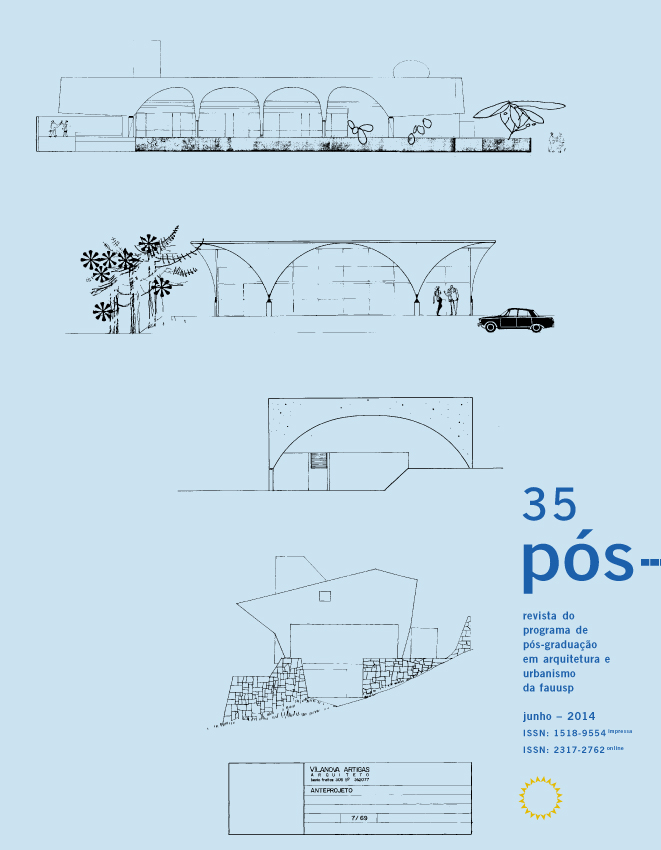Church of rammed earth to cathedral: historical and architectonic aspects of the mother church of São Paulo
DOI:
https://doi.org/10.11606/issn.2317-2762.v21i35p186-199Keywords:
Cathedral of Sé in São Paulo. Mother church. History of São Paulo. Neogothic architecture. Ancient structures. Renaissance dome.Abstract
São Paulo of Piratininga, as Brazil, was born under the symbol of the cross. During the first decades of the 1500s, there were few places that offered so much abundance as the region inhabited by the tupiniquim indians, called Fields of Piratininga, which means “dried fishes”. The reference point of the oldest catholic settlements was the mother church, from which the new cities emerged. Inaugurated on January 25th 1954, at the fourth centenary of the foundation of the city of São Paulo, the Cathedral of Sé, built predominantly in gothic style, is a historical, religious and social symbol. Its architecture holds the beliefs of the people and the square in front of it is the scene of popular demonstrations. The verticality and the light provided by its colorful glass windows, typical features of gothic structures, seek to create an atmosphere of ascension towards heaven. This style is only broken by the presence of an unusual structural element in buildings with this architecture: a renaissance dome. In 1934, the square of the church became the zero mile marker of the city. In the 70s, it received a subway station. In the Cathedral, monuments, like the statue of Padre Anchieta, are present. It is also a meeting place for the unemployed. And right in front of this public area is the Cathedral, built next to Praça João Mendes. This article presents some historical and architectural aspects that have led to the construction of the current mother church of the city: the Cathedral of Sé. Previous buildings are presented and the motivations of its construction, especially the architectural ones are highlighted, in order to help the enrichment of the history of the city of Sao Paulo.Downloads
References
A CATHEDRAL de São Paulo. São Paulo: [s.n], [1911 - ?].
ALBUQUERQUE, Alexandre. A Cathedral de São Paulo. São Paulo: Melhoramentos, 1929. 31 p.
ARQUIVO HISTÓRICO MUNICIPAL/DPH. Aquarelas de J. Wasth Rodrigues. Prefeitura de São Paulo. Arquivo Histórico Municipal/DPH. 1999. Disponível em: http://portal.prefeitura.sp.gov.br/secretarias/cultura/patrimonio_historico/0001/galeria_sp_aquarela/. Acesso em: 12 abr. 2004.
ARROYO, Leonardo. Igrejas de São Paulo. São Paulo: Brasiliana, 1966. 322 p.
COMISSÃO EXECUTIVA DA NOVA CATEDRAL DE SÃO PAULO. Relatório n. 3 - 1915. São Paulo: TVP Cardozo Filho & Comp., 1916. 21 p.
DACIOLE, Leonardo. Fotos do Brasil. Catedral da Sé. Disponível em: http://www.fotosdobrasil.fot.br/Sudeste/SaoPaulo/CatedralDaSe.htm. Acesso em: abr. 2008.
DIAS, Pollyanna D’Avila. O século XIX e o neogótico na Arquitetura brasileira: um estudo de caracterização. Revista Ohun. n. 4, p. 100-115, 2008. Disponível em: http://www.revistaohun.ufba.br/pdf/Polyana_DAvila.pdf. Acesso em: 28 jan. 2014.
SANTOS, Maria das Graças Proença. História da arte. 16 ed. São Paulo: Ática, 2002. 279 p.
FAUSTO, Boris. História do Brasil. São Paulo: Edusp, 2003. 688 p.
FOLHA DE SÃO PAULO. A nova Catedral. Catedral da Sé. Galeria de Imagens. Foto: Rogério Cassimiro. 2002. (il. 4). Disponível em: http://www1.folha.uol.com.br/folha/especial/2002/catedraldase/. Acesso em: 24 abr. 2003.
LEITE, Monsenhor Manfredo. A Catedral de São Paulo. São Paulo: Elvino Pocai, 1954. 17 p.
MATTOS, Monsenhor Sylvio de Moraes. A nova Catedral de São Paulo. São Paulo: Arquidiocese de São Paulo, 1992. 156 p.
NOGUEIRA, Amadeu. História da Catedral de São Paulo. Revista Paulistania. n. 37. São Paulo: Clube Piratininga. nov./dez. 1950. p.14-17.
PINTO, Adolpho. A Cathedral de São Paulo. São Paulo: Arquidiocese de São Paulo, 1929. 21 p.
PINTO, Adolpho. A Cathedral de São Paulo. São Paulo: Empreza Graphica da Revista dos Tribunaes, 1930. 126 p.
RAMIREZ, Karen Niccoli. Análise do comportamento estrutural da Catedral da Sé de São Paulo: aspectos históricos, arquitetônicos e estruturais. 2010. 223p. Tese (Doutorado) - Escola Politécnica, Universidade de São Paulo, São Paulo, 2010.
RAMIREZ, Karen Niccoli. Catedral da Sé de São Paulo: aspectos históricos, arquitetônicos e estruturais. 2005. 167p. Dissertação (Mestrado) - Escola Politécnica, Universidade de São Paulo, São Paulo, 2005.
THURLER, Monsenhor José. Guia da Catedral Metropolitana de São Paulo. São Paulo: Arquidiocese de São Paulo, 1956. 153 p.
Downloads
Published
Issue
Section
License

This work is licensed under a Creative Commons Attribution 4.0 International License.
DIADORIM - Diretório de Políticas Editoriais












